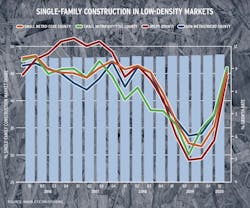Surprise Jobs Rebound Could Trigger Recovery
The May jobs report showed the kind of rebound America has been waiting for since the onset of stay-at-home orders instituted to slow the spread of the novel coronavirus. As businesses reopen and people get back to their jobs, the residential construction industry is poised to take advantage of improving conditions.
After losing almost 1.4 million jobs in March and more than 20 million jobs in April, the nation added 2.5 million jobs in May, according to the Department of Labor’s Bureau of Labor Statistics. However, millions of Americans remain out of work, and the unemployment rate, which fell to 13.3% from 14.7% in April, remains at it’s highest level since World War II. But the 2.5 million jobs added in May suggest the recovery from the pandemic-caused downturn may come sooner than many anticipated.
As jobs numbers show signs of improvement, the National Association of Home Builders’ economics team sees the potential for residential construction to lead the economy out of the downturn, based on analysis of key housing data sources. The housing industry entered this recession underbuilt, and a combination of pent-up demand and lower interest rates puts new-home construction in a position to recover more quickly than many other sectors of the economy.
Another metric that suggests housing will lead the rebound is mortgage purchase applications, which increased for the sixth straight week at the end of May, supported by historically low mortgage interest rates (3.4% on average). The data showed a 9% week-over-week gain, with a 54% improvement since early April.
... a combination of pent-up demand and lower interest rates puts new-home construction in a position to recover more quickly than many other sectors of the economy.
The mortgage gains came ahead of April’s surprising new-home sales data. The estimates revealed that the seasonally adjusted annual sales pace of new, single-family homes was effectively unchanged from March, with the measured volume at a 623,000 annualized rate. The surprising April data and strong start in the first two months of 2020 left new-home sales for the first four months of the year 1% higher than the first four month of 2019. That 1% gain comes despite the fact that two of those four months, March and April, saw some of the most challenging economic conditions in U.S. history.
Government efforts to shore up employers and families during the downturn, and the speed at which businesses and public life return to normal operation, will affect the pace of the recovery. But on the current path, new residential construction is likely to lead the way as America gets back on track.
RELATED
Home Starts Pick Up in Small Towns and Rural Markets
The COVID-19 pandemic will likely accelerate the trend of residential construction activity in smaller cities, rural areas, and other lower-density markets, a trend seen in data from NAHB’s latest quarterly Home Building Geography Index (HBGI). The combined shares of lower density markets, which includes core metro areas of small cities, has gradually increased since 2016 to about 47% of all single-family builds. These less-dense markets comprise roughly 44% of the U.S. population.
The data also show that small-town (micro-county) single-family home building prospects were very strong in 2017 but slowed during the interest-rate–induced housing affordability soft patch of 2018/2019.
One lesson from this public health crisis is that major metropolitan areas have faced greater challenges during the pandemic. High-density lifestyles, championed by some planners over the last decade as a rival to suburban living, have proved to be vulnerable to the disease because of crowded living conditions, dependency on mass transit, and insufficient health care and public-sector infrastructure.
ABOUT NAHB: The National Association of Home Builders is a Washington, D.C.-based trade association representing more than 140,000 members involved in home building, remodeling, multifamily construction, property management, subcontracting, design, housing finance, building product manufacturing, and other aspects of residential and light commercial construction. For more, visit nahb.org.

